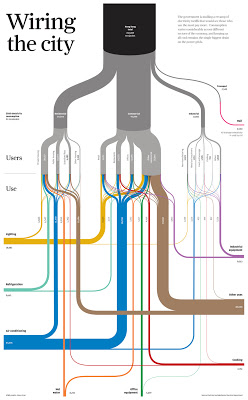The Technology Alliance Group invited me to talk about information overload last week. There's a great McLuhan quote - perhaps apocryphal - something like "We don't know who discovered water, but we're pretty sure it wasn't the fish." Asking just about anyone about information overload is pretty much like asking a fish about water - me included. However...having thought about this quite a bit, I think it's a bigger issue than we realize.
Ask yourself this, if you're over 30. Has your reading changed? I don't mean what you read - that, certainly - but HOW you read. My sense is that I skim & scan much, much more than I used to. (And "avid reader" doesn't begin to describe my appetite for reading.)
The issue isn't reading and reading habits - it's coping. Here's the problem, in a visual of course:
The Library of Congress adds about 11,000 volumes per day - total to date, 32 million.
Clive's estimate is the equivalent of 520 million books.
Result: 4,727-to-1.
What we used to think of as formal knowledge - the stuff that goes in library - is outweighed thousands-fold by the social stuff. But wait, it gets more interesting.
LOC has 32 million volumes. Founded in 1815 - 198 years ago. Multiply by 365 to get 442 volumes per day, on average. But the current rate is 11,000 per day. Has the rate of acquisition of formal knowledge gone up? Sure - dramatically.
I think we're creating a problem that we're not quite culturally ready to 'fess up to (except Ray Kurzweil & his fans.) Overload? The word doesn't really capture the issue, does it. It has a sense of voluntary taking-on-a-bit-much, with a smidge of pride. We're not "overloaded" - we are incapable of handling this much information in the ways we've handled information for the past 500 years or so.
If you deal with information and knowledge in your profession, you're rightfully proud of both the knowledge you've got, and your skill at adding to it. Saying "I can't keep up" doesn't really square with that very easily. Honestly, though - you're not "keeping up." I'm not "keeping up."
The techno-centric response is to point at the knowledge tools we've added - search engines, software, "big data" tools, blah blah blah. No argument from me, take away my browser and suddenly I'm not half the borg I used to be. But I don't think my capacity for knowledge acquisition - for adding to what I know and associating it with what I knew - is 4,000 times greater than Grandpa had. It's probably the same; Jared Diamond says something to that effect in Guns, Germs & Steel as I recall - the guy whose life depends on plants and grass can make a huge number of distinctions, where an idiot like me just sees grass.
Is this a waste of time in the face of the bitflood? Yes - and no. One of the reasons I like working with visual and narrative communication is that it often works when words don't. It's not a panacea - I don't know about you, but I've started to "read" infographics with the same impatient handling reserved for email. But it's at least an attempt to reframe communication challenges in light of this big contextual overload issue.
The rise of "design" strikes me as a response to all this, in a sense. That's another post. I have stuff to read ;-)
--md


